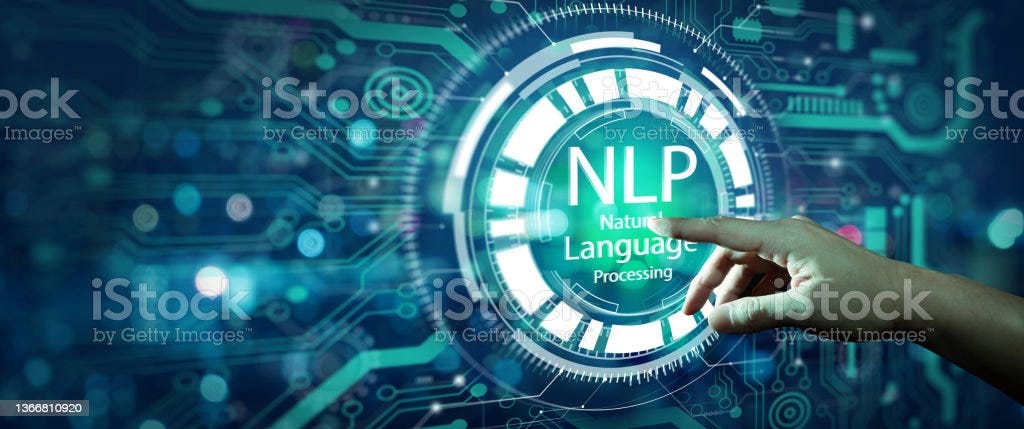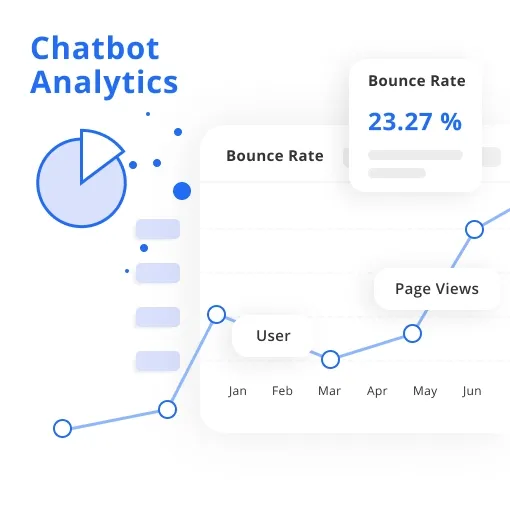What is Chatbot Analytics

Chatbot analytics is tracking and analyzing data related to chatbot performance. It involves monitoring user interactions, technical performance, and business outcomes to understand better how chatbots are performing and where to improve.
It involves tracking several metrics, including engagement, operational, and business metrics.
By tracking these metrics, businesses can gain valuable insights into how their chatbots are performing and how they can optimize their chatbot experiences.
Engagement Metrics
User Interactions
User interactions refer to the number of interactions with a chatbot. This metric measures the engagement level of users with the chatbot. It can be used to identify popular topics or areas where the chatbot may need improvement.
An example of a user interaction would be a user asking the chatbot for help with a specific problem.
User Satisfaction
User satisfaction refers to users' satisfaction with the chatbot's responses and overall experience. This metric is typically measured through user feedback surveys or sentiment analysis tools.
An example of user satisfaction would be a user rating the chatbot's response as helpful or unhelpful.
Message Open Rate
Message open rate refers to the percentage of messages that users open. This metric can identify the effectiveness of chatbot messaging and help businesses optimize their chatbot content.
An example of a message open rate would be 50% of users opening a message from the chatbot.
Message Response Rate
Message response rate refers to the percentage of messages that are responded to by users. This metric measures the effectiveness of chatbot messaging. It can be used to identify areas where the chatbot may need improvement.
An example of a message response rate would be 80% of users responding to a message from the chatbot.
Operational Metrics
Uptime
It is the percentage of time that the chatbot is available and operational. This metric measures the technical reliability of the chatbot and can be used to identify areas where to make improvements.
An example of uptime would be the chatbot being available and operational 99.9% of the time.
Error Rate
Error rate refers to the percentage of errors that occur during user interactions with the chatbot. This metric measures the technical performance of the chatbot. It helps to identify areas where the chatbot may be failing users.
An example of an error rate would be 5% of users experiencing an error when trying to interact with the chatbot.
Latency
It is the time it takes for the chatbot to respond to user messages. This metric measures the technical performance of the chatbot. It helps to identify areas where the chatbot may be slow or unresponsive.
An example of latency would be the chatbot responding to user messages within 1-2 seconds.
Business Metrics
Cost per Conversation
It refers to the cost of each conversation the chatbot handles.
This metric measures the financial impact of the chatbot. It helps to identify areas where cost savings can be made. An example of cost per conversation would be $2 per conversation handled by the chatbot.
Conversion Rate
It refers to the percentage of conversations that result in a desired action, such as a sale or a lead. This metric measures the chatbot's effectiveness in driving business outcomes. It helps to identify areas where the chatbot may need improvement. An example of a conversion rate would be 10% of conversations resulting in a sale.
Return on Investment
It refers to the financial return on investment generated by the chatbot. This metric measures the impact of the chatbot on the business. It can be used to justify investment in chatbot development. An example of ROI would be a 200% return on investment from the chatbot.
Customer Lifetime Value
It refers to the total value of a customer over their lifetime with the business. This metric measures the impact of the chatbot on customer retention. It helps to identify areas where the chatbot can improve customer value. An example of CLV would be a customer with a lifetime value of $10,000.
Advanced Metrics
NLP Metrics

Intent Recognition Rate: This metric measures the percentage of time that the chatbot correctly identifies the user's intent. For example, if a user asks the chatbot for help with a billing issue, the intent recognition rate would measure how often the chatbot correctly identifies that the user needs help with billing.
Entity Extraction Accuracy: This metric measures the accuracy of the chatbot's entity extraction capabilities. Entity extraction refers to identifying important information in user messages, such as names, dates, and other relevant data.
Sentiment Analysis: This metric measures the ability of the chatbot to detect and respond to user sentiment accurately. Sentiment analysis tools can help chatbot developers understand how users feel about their interactions with the chatbot and make adjustments as needed.
Channel-Specific Metrics
Chatbot Usage by Channel: This metric measures the number of users and interactions on each channel where the chatbot is available. It can help you understand which channels are most popular for your chatbot and where to focus your efforts.
Click-Through Rate: This metric measures the percentage of users who click on a link provided by the chatbot. This can be a useful metric for chatbots that provide users with links to external content or resources.
Pageviews: This metric measures the number of times that users view a page linked to by the chatbot. This can be a useful metric for chatbots that provide users with links to internal content or resources.
Chatbot-Specific Metrics
Abandonment Rate: This metric measures the percentage of users who abandon their interaction with the chatbot before completing their intended task. This can be a useful metric for identifying areas where the chatbot may confuse or frustrate users.
Conversation Completion Rate: This metric measures the percentage of users who complete their intended task while interacting with the chatbot. This can be a useful metric for identifying areas where the chatbot may fall short in helping users accomplish their goals.
Escalation Rate: This metric measures the percentage of interactions escalated to a human agent. This can be a useful metric for understanding when users need additional support beyond what the chatbot can provide.
Setting Goals and KPIs
To get the most out of your chatbot analytics, it's important to set clear goals and key performance indicators (KPIs) that align with your overall business objectives. Here's how to get started:
Defining Goals
Before you can set KPIs, you need to define your goals for the chatbot. Your goals should be specific, measurable, and aligned with your business objectives. Here are some examples of goals you might have for your chatbot:
Increase customer satisfaction: One goal for your chatbot might be to improve customer satisfaction by providing faster and more accurate support.
Reduce customer support costs: Another goal might be to reduce the cost of customer support by shifting more interactions to the chatbot.
Increase sales: If your chatbot is designed to support sales, your goal might be to increase the number of sales generated through the chatbot.
Setting KPIs
Once you've defined your goals, it's time to set KPIs to help you measure progress. Your KPIs should be specific, measurable, and directly tied to your goals. Here are some examples of KPIs that align with the goals listed above:
Increase customer satisfaction:
User satisfaction score: Measure user satisfaction with the chatbot on a scale of 1-5.
First response time: Measure how quickly the chatbot responds to user messages.
Reduce customer support costs:
Cost per conversation: Measure the cost of each conversation handled by the chatbot.
Deflection rate: Measure the percentage of interactions that are successfully handled by the chatbot without the need for human intervention.
Increase sales:
Conversion rate: Measure the percentage of conversations that result in a sale.
Average order value: Measure the average sales value generated through the chatbot.
Setting clear goals and KPIs ensures you're measuring the right metrics and tracking progress toward your business objectives. Over time, you can use your chatbot analytics to make data-driven decisions that improve the performance and effectiveness of your chatbot.
Frequently Asked Questions about Chatbot Analytics
1. Why is chatbot analytics important for businesses?
Chatbot analytics is important for businesses because it helps them understand how their chatbots perform and where they can improve them. By tracking and analyzing chatbot performance, businesses can optimize their chatbot experiences, improve customer satisfaction, and achieve their business goals.
2. What are some examples of engagement metrics in chatbot analytics?
Examples of engagement metrics in chatbot analytics include user interactions, user satisfaction, message open rate, and message response rate. These metrics help businesses understand how engaged users are with their chatbot and where they may need to improve.
3. What are some examples of operational metrics in chatbot analytics?
Examples of operational metrics in chatbot analytics include uptime, error rate, and latency. These metrics help businesses understand the technical performance of their chatbot and where they may need to make improvements.
4. What are some examples of business metrics in chatbot analytics?
Examples of business metrics in chatbot analytics include cost per conversation, conversion rate, return on investment, and customer lifetime value. These metrics help businesses understand the financial impact of their chatbot on the business and where they may need to make improvements.
5. What are some examples of advanced metrics in chatbot analytics?
Examples of advanced metrics in chatbot analytics include intent recognition rate, entity extraction accuracy, sentiment analysis, chatbot usage by channel, click-through rate, page views, abandonment rate, and conversation completion rate. These metrics help businesses understand the performance of their chatbot in more detail and where they may need to make improvements.

